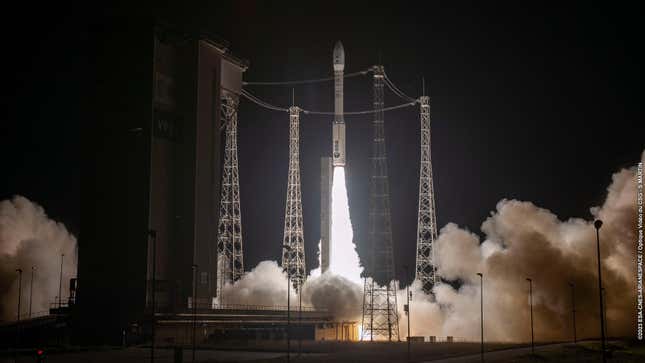
Arianespace’s latest Vega mission failed to deploy two of its payloads to orbit, likely due to a failure with the release mechanism with the rocket’s upper stage.
Vega VV23 lifted off on October 8 from Europe’s Spaceport in French Guiana at 9:36 p.m. ET. The rocket was carrying an Earth observation satellite and a weather satellite, as well as 10 cubesats. Shortly after launch, Arianespace announced that its primary payloads, the Airbus Defense’s THEOS-2 and the Taiwan Space Agency’s FORMOSAT-7R/TRITON satellites, and eight of its secondary payloads were successfully deployed. The company noted, however, that the separation of two cubesats “is still to be confirmed.”
Advertisement
Arianespace reportedly sent an email to the respective customers behind the two cubesats, according to European Spaceflight, saying that the company now has “the strong suspicion that your satellites ESTCube-2 and ANSER-Leader were unfortunately not separated from their respective deployers.” The email went on to say that telemetry data on the end-switch of the deployers were not received, and that data showed only 10 objects in orbit rather than 12.
Advertisement
The two satellites likely remained attached to the rocket’s upper stage and burned up in Earth’s atmosphere during reentry. ESTcube-2 was designed by the Estonian Student Satellite Foundation to test a new method for disposing satellites using a plasma brake. The second cubesat, ANSER-Leader, was one of three satellites launched aboard the VEGA VV23 mission for the Spanish National Institute of Aerospace Technology (INTA).
Advertisement
The failure is the latest incident in Europe’s growing rocket woes. Virgin Orbit ran intro financial ruin following the unsuccessful “Start Me Up” mission in January of this year. The failed launch, which was meant to mark a historic moment for satellite launches from British soil, significantly impacted the company’s projected revenue and future prospects, with the company finally declaring bankruptcy in March. Arianespace’s Vega C rocket failed to reach orbit during its second launch in December 2022, and remains grounded. Ariane 6, a successor to Ariane 5, was originally slated for launch in 2020 but a series of technical hiccups have delayed its inaugral launch to 2024.
Europe is in desperate need of more launch vehicles after cutting ties with Russia following the invasion of Ukraine and being forced to stop relying on the Soyuz rockets for access to space. Vega VV23’s failure to deploy two of its payloads just adds more uncertainty to the European space industry.
Advertisement
For more spaceflight in your life, follow us on X (formerly Twitter) and bookmark Gizmodo’s dedicated Spaceflight page.
Services Marketplace – Listings, Bookings & Reviews